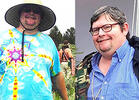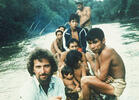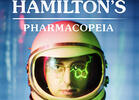
Hamilton Morris tweeted on April 27. "The Great Peter Gorman died this week shortly after his final expedition in South America."
The great Peter Gorman died this week shortly after his final expedition in South America, he was the first outsider to try the skin secretions of Phyllomedusa bicolor, you can listen to him telling the story here: https://t.co/SGTvK5cY0m
— @hamiltonmorris (@HamiltonMorris) April 27, 2022
Morris interviewed Peter Gorman before he left on that last expedition.
I was hoping Gorman would have stay home in Texas instead of traveling to Peru like he loved to do this final time. The last few trips landed him in the hospital with major infections and even a flesh-eating disease.
At 71, Gorman wasn't in the best of health. He chain-smoked, suffered from emphysema and was overweight. According to his friend Malcolm MacKinnon, Gorman returned to Texas in bad shape and went into ICU. He died on April 24. His brother Michael told MacKinnon: "He didn't want to waste away at home. He wanted to give the Amazon one last shot." MacKinnon added: "Apparently, he was out of it on the boat, but managed to make it through. That was Peter. He loved the extremes."
Gorman was part of the High Times editorial staff when I was hired in 1988. He specialized in jungle drugs like ayahuasca, or what William S. Burroughs called yagé. A photographer, MacKinnon accompanied him on many HIgh Times assignments before becoming a staffer in 1992.
In his last book, the self-published Magic Mushrooms in Indian and Other Fantastic Tales from 2021, Gorman wrote:
"The first time I ever smoked pot and hash was at Woodstock. It was an event that I mostly remember as a blur. It was the summer of 1969 and I was 19 years old. But something had happened there and when I returned from the festival I was different. I hadn't had the greatest time in the world there, hadn't done acid yet, but I had gotten high from the hash and the pot, and I had changed. I suppose it started a year earlier, when I'd hitchhiked to Kentucky and worked on a tobacco farm for a couple of months. But Woodstock had cemented it: I was a longhair at heart and in spirit."
Peter Gorman: "I paid a good price for my curiosity."
Gorman grew up in Queens, NY in a large Irish-American family. He attended Hunter College, but never graduated. He had a lot of odd jobs, including driving a cab. Gorman helped paint Jimi Hendrix's Electric Lady recording studio on W. 8 St. in Greenwich Village. But mostly he was a chef in the vein of Anthony Bourdain. Gorman loved to cook and devoted many Facebook posts to recipes.
He came to the attention of High Times in 1986. "I'd done some stories on ayahuasca, nu-nu, the psychedleic plant doctor," he recalled. Gorman began traveling to South America, developing his skills as an ethnobotanist. He also inteviewed all of the psychedelic pioneers - from Albert Hofmann, Richard Shultes and Terence McKenna to Ann and Alexander Shulgin and Rick Doblin. "I was kind of on a hot streak at High Times. I don't know how I managed to get so lucky to get so many people who are fascinating in their fields to decide this guy's worth spending several hours with."
Morris' tweet refers to Gorman's discovery of how frog sweat can alter human consciousness. To Morris, it's kambu; Gorman called it sapo. The secretion is burned into the flesh.
Gorman scored interviews with Matsés Indians in the Amazon, who taught him how to use the hallucinatory secretion.
He met a shaman named Moises who trained him as an apprentice. Gorman used ayahuasca many times and eventually wrote the book, Ayahuasca in My Blood: 25 Years of Medicine Dreaming.
After writing hundreds of articles in HIgh Times and a stint as editor-in-chief, he returned to Iquitos. Peru, the Westernmost city on the Amazon where he opened a bar and met a local woman who would become his wife. Gilma had two young boys. They all moved to New York and lived in Peter's Upper East Side apartment. We all got to know each other, and played softball together on the HIgh Times team, the Bonghitters.

Gorman wrote more articles, but Gilma (a.k.a. Chepa) was not happy in New York and moved with the kids (they now had one of their own) to Texas where her sisters lived. Though their marriage was not going well, Gorman followed her to Joshua, a town south of Dallas. There Chepa had several more children with another man. They lived near each other and all the kids (and grandkids) grew up together harmoniously.
Leaving High Times behind after 15 years, Gorman became a staff writer at Fort Worth Weekly. He wrote articles and continued to to go the Peru. (Gorman also wrote a monthly column for Skunk.) Soon he started a tour and took people there to experience ayahuasca. The boat trips are straight out of Fitzcarraldo. In the "Peru" chapter in Magic Mushrooms, he tells of a boat with a hole in it: "I began tossing things overboard. First went two stems of platanos, then a 50-pound bag of rice and a sack of sugar. Next went a sack of yucca. I looked at the hole: The boat had risen to the point where the hole was almost above the water line. Another arm of platanos went over, then another sack of yucca."
Gorman did Amazon tours twice a year for a number of years and even had a jaunt to Machu Picchu. I regret having never joined him. About his various ailments and injuries that included malaria and snake bites, Gorman told Morris: "I paid a good price for my curiosity."
The last time I saw Gorman was when he returned to New York to speak at an ayahuasca event sponsored by Reality Sandwich at Webster Hall in 2010. Gorman arrived with two of his kids. He shared some stories with the crowd and then we went out for pizza.
Gorman was since featured in the independent documentary More Joy Less Pain. Maybe someone will make a feature movie about this extraordinary, garrulous New Yorker who had a major impact on the world of psychedelics.
"It is with great sadness that we inform you that former Fort Worth Weekly staff writer and all-around raconteur Peter Gorman died on Sunday," the paper reported on April 27. "Peter started writing for us in the early aughts, and throughout all of his great investigative work - he scared natural gas companies to death - and food reviews, he continued working as a Peruvian jungle guide and doting on his children."






